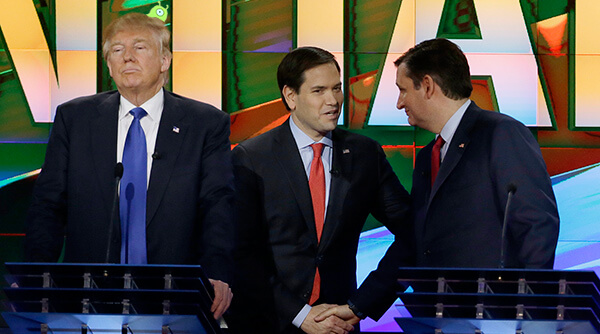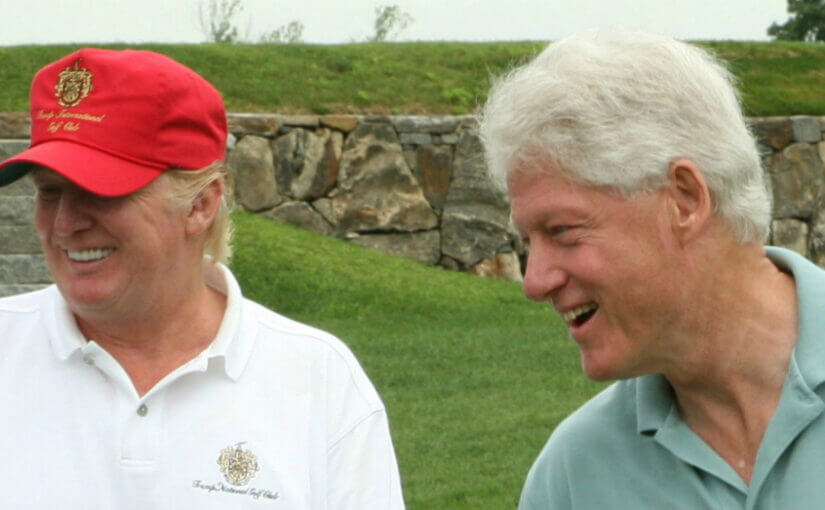Category: Poll and Election Analysis
How Much Does Gerrymandering Really Matter?
Five Lanes in the 2020 Democratic Field
How Often Is One State Decisive in the Electoral College?
How the Polls Broke at the End
2018: Normalcy’s Revenge
Breaking Down the Polls at the End
How Are the Senate Races Breaking Now?
How Will the Governors’ Races Break?
How Will the Senate Races Break?
Trump’s First Year: The Ominous Signs Ahead
WaPo and The Hill Publish ‘Troll Poll’ about Postponing the 2020 Election
Do Democrats Really Want Their Own Tea Party? Be Careful What You Wish For
The Real Reason Trump Won: Part 4 of 4
NRO: The Real Reason Trump Won: Part 4 of 4, looking at where Trump underperformed other Republican candidates.
The Real Reason Trump Won: Part 3 of 4
NRO: The Real Reason Trump Won: Part 3 of 4, looking at each side’s state-by-state turnout as a percentage of the Voting-Eligible Population.
The Real Reason Trump Won: Part 2 of 4
NRO: The Real Reason Trump Won: Part 2 of 4, looking at how Trump performed in the battleground states by historical standards for post-incumbent challengers.
The Real Reason Trump Won: Part 1 of 4
NRO: The Real Reason Trump Won: Part 1 of 4, looking at how Trump performed nationally by historical standards for post-incumbent challengers.
Hillary Clinton: President of California
New York’s Vote Was A Microcosm of America in 2016
The Electoral College Is Not Like Slavery
Hillary Voters: The Minority in 37 States
Does Donald Trump Have a Mandate?
A Republican Win, Not Just A Trump Win
How Will The Senate Break?
My Final Prediction: Hillary 303, Trump 235
Where Trump Stands Right Now
Republican Senators Still Swimming against the Trump Tide – for Now
The Not-Hillary Campaign
Polling is Art, Or Craft; It’s Not An Exact Science
How Trump Compares To Bush, McCain and Romney at this Stage
Good Polling News for Republicans, Even Trump
Trumpism’s Bad Night By The Numbers
How to Tell If the GOP Has Become a Trump Party
Pew: The Voters Lose Faith In The Voters
How Bad Are Trump’s National Polls? Some History.
Donald Trump Is Down 46-35 To Hillary Clinton In His Favorite Poll
The Dog That Didn’t Bark: Trump Voters in Down-Ballot Primaries
A Very Different Republican Coalition: Can It Fly?
RS: A Very Different Republican Coalition: Can It Fly?
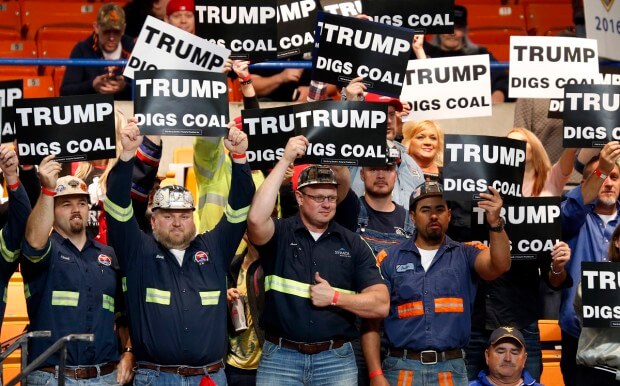
There’s been a lot of attention paid to Donald Trump’s appeal to a particular type of voter: white working class, no college degree, not that religious or socially conservative but anti-immigration. Let’s look at a few exit poll numbers to contemplate how a Trump coalition might be shaped very differently from Mitt Romney’s coalition, which drew together a respectable but insufficient 47% of the general electorate.
I did some simple algebra combining the share of each group in the electorate and the share won by each candidate, to consider what chunk of their voters fell in each group. For example, college graduates were 45% of the 2012 general electorate and Romney won 48% of them, so whereas non-college-grads were 53% and Romney won 47% of them – thus college-educated Romney voters were 23% of all voters, non-college-educated Romney voters were 25% of all voters, and accordingly college-educated voters made up 48% of the Romney vote. For purposes of this exercise I looked back at the Trump coalition in three states that were decisive (Indiana, Florida and South Carolina). While primary and general election coalitions are different animals, this is the data we have to work with so far, and it gives us a clue as to some of Trump’s challenges ahead, as well as how a candidate with Trump’s appeal to such groups could be an electoral force if that candidate wasn’t also as off-putting as Trump is to other core elements of the Romney coalition.
Continue reading A Very Different Republican Coalition: Can It Fly?
Trump’s Next Victim: Pollsters
RS: Trump’s Next Victim: Pollsters
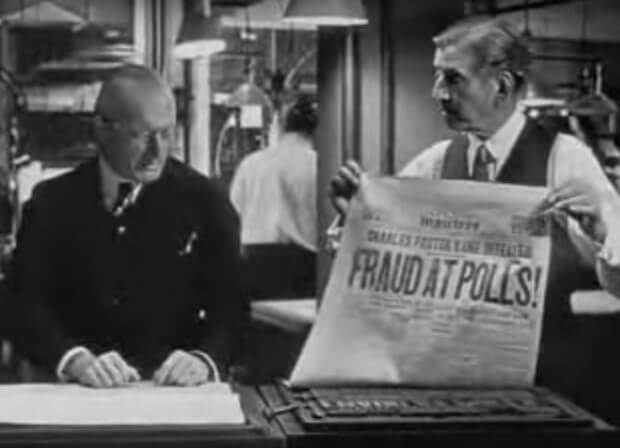
Donald Trump has proven adept at corrupting everyone and everything that comes into his orbit. He has constructed a kind of cargo-cult imitation of a real political campaign, with press flacks and pundits and elected officials and “policy advisors” and even now speechwriters all acting as if Trump was a real candidate rather than a bad joke told too long. But the one thing Trump has not really needed so far was thoroughly bogus general election polls. Oh, his strength has been overstated in some national primary polls, and the online Reuters poll has been a particular favorite. But Trump in the primaries has mostly been content to tell bald-face lies about his polling against Hillary Clinton, content that any rebuttal could be shouted down with “BUT I AM BEATING YOU IN THE PRIMARY SO YOU MUST BE WORSE.”
What To Watch For In Tonight’s NY Republican Primary
RS: What To Watch For In Tonight’s NY Republican Primary
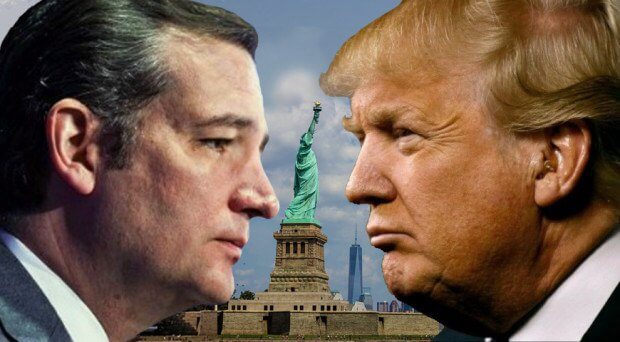
The stakes are high for Donald Trump tonight in his home state of New York. Ted Cruz and John Kasich would probably be out of the race now without big wins in their home states (Cruz beat Trump by 17 in Texas, Kasich swept all 66 delegates in Ohio; Marco Rubio dropped out after losing Florida). Trump needs a lot of delegates from the Northeastern primaries between today and next Tuesday if he is to have any hope of getting to the 1,237 pledged delegates he needs to avoid a contested convention fight he is likely to lose. 95 delegates are at stake in New York; Trump is unlikely to get a complete clean sweep of them, but he needs to clear 50% of the statewide popular vote and 80 or so delegates to retain any chance of reaching 1,237. Here’s what to watch for tonight:
When will results be reported? In general elections, New York is usually called by the networks the instant the polls close, but that’s because the major statewide races are lopsided. But this is – as discussed below – a statewide race plus 27 local races, and some of those may vary widely in how quickly they report results. Past experience is hard to generalize from, because (1) New York’s optical-scanner machines are relatively new, New York having stuck for many years with the old fashioned lever-pull machines that people in other states have only seen in movies; (2) vote-counting was really slow in 2012’s general election due to Hurricane Sandy. Early reports have lots of SNAFUs. So, stay tuned, we could be here a while. But don’t touch that dial – RedState will have coverage throughout the evening.
How are delegates awarded? New York’s method of awarding its 95 delegates is neither a purely proportional nor purely winner-take-all system, and is somewhat similar to what we’ve seen previously in Illinois and will see later on in California, Connecticut, and Washington. 14 bound delegates are awarded on the basis of statewide results; the other 81 are awarded on the basis of the voting in each of the state’s 27 districts, 3 per district.
Will Trump win? Yes, barring a truly improbable polling miss. As Leon noted earlier, the pollsters have struggled this year, but they are pretty unanimous that Trump is way ahead and very likely to break 50% statewide, which means he would also break 50% in at least 10-12 districts, probably more. The polling also has Cruz finishing third behind Kasich and probably struggling a bit to break 20% statewide. New York is just a bad state for Cruz, compounded by his slam on Trump’s “New York values” during the Iowa race (which amazingly was only three months ago). Long Island Republican Pete King, who previously endorsed Rubio and is the only elected pro-lifer anywhere near New York City, hates Cruz so much he says he would take cyanide if Cruz was the nominee.
We can, however, generalize about a few things. Trump is likely to utterly dominate the Buffalo area districts like NY-23 through NY-27 (a stronghold for Carl Paladino, the proto-Trump who was our disastrous gubernatorial nominee in 2010), Staten Island (NY-11), and probably several other districts in Brooklyn, Queens and Long Island like NY-1 through NY-6, NY-8. He also looks to be very strong in NY-17 and NY-18, the districts just north of Westchester and Rockland. Endorsement-wise, New York is Trump’s best state: among others, he has Paladino, Rudy Giuliani, and a couple of Congressmen around Buffalo.
His main competition downstate (from Westchester on down) will be Kasich, who some polls have shown to be surging; Kasich is the kind of candidate that Republicans in places like Manhattan and Westchester are likely to warm to. I live in NY-6 in Queens (a district that is heavily Democratic and 40% Asian, one of the most Asian districts in the country), and I’ve seen nothing of the Cruz campaign while being bombarded with robo-calls for Kasich, who also has signs up around the highways. Kasich’s endorsers include George Pataki (who previously backed himself and then Rubio), 2013 Mayoral candidate Joe Llhota, and possible 2017 Mayoral candidate Eric Ulrich. Cruz has…don’t ask.
But the real Cruz-Trump battleground will be the heart of upstate, the mostly Republican districts around Albany, Syracuse, and the Adirondacks, NY-20 through NY-24, maybe NY-25. Those are the places that will really decide how strong Trump is tonight.
Who can vote? Well, it’s a little late to ask that now, eh? It’s a closed primary, and New York has the earliest deadline in the country to change your party registration – you had to do it before last Election Day in November. Worse yet, the Board of Election website simply tells voters:
How to Make Changes to Your Registration
Change of Name and/or Address
The voter registration form should be used as a change of address form. Notices of change of address from registered voters received at least 20 days before a special, primary or general election by a county board of elections must be processed and entered in the records in time for that election.
Change of Party Enrollment
The voter registration form should be used to change your party enrollment from one party to another or to enroll for the first time in a party. A change of enrollment received no later than 25 days before the general election shall be deposited in a sealed enrollment box and opened the first Tuesday following that general election and entered in the voter’s registration record.
How do I change my enrollment?
If you wish to change your enrollment from one party to another or from not-enrolled to a party, send a Voter Registration Form with your new choice to your county board of elections. The board will notify you when the change takes place, by Law, after the next general election.
You gotta read those real carefully to notice that this means 25 days before the last general election for this primary; the website nowhere mentions the deadline explicitly. That’s bad for Trump, and polling places are apparently collecting plenty of provisional ballots from people who don’t qualify, which presumably will never be counted. Two of Trump’s children and his own lawyer are among those who won’t be able to vote for him. If Trump underachieves tonight, expect that to be a major reason why.
What does Trump need? This is where the context gets important. Look at the calendar ahead:
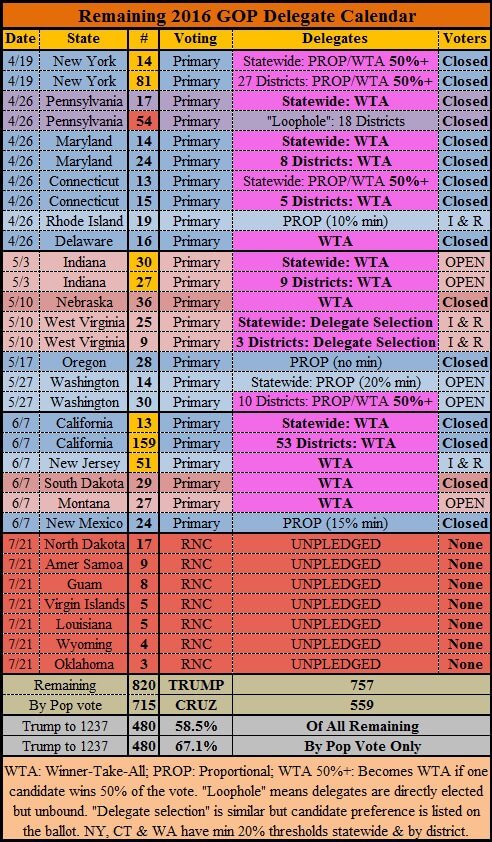
Trump is widely expected to dominate the Northeast, but after that, only West Virginia and New Jersey are really likely Trump country rather than contested turf. And Trump at this writing has – the count varies by source – 44.5% of the delegates awarded so far. If he isn’t sitting on 50% or more at the end of this month, it seems pretty hard to see him getting there by June 7. But how dominant does Trump need to be in order to get to 50% before Indiana, so that he can just split the rest of the way and win 1,237 delegates?
So, expect good news for Donald Trump tonight, on its face – but news that may actually be very bad for him if he’s bringing home 70 or 75 delegates.
After Wisconsin, By The Numbers
Can Donald Trump or Ted Cruz Beat Hillary Clinton? A New National Poll May Surprise You
Ted Cruz or Bust: Armageddon Tuesday By The Numbers
This Is Not 1980, And Donald Trump Is Not Ronald Reagan
RS: This Is Not 1980, And Donald Trump Is Not Ronald Reagan
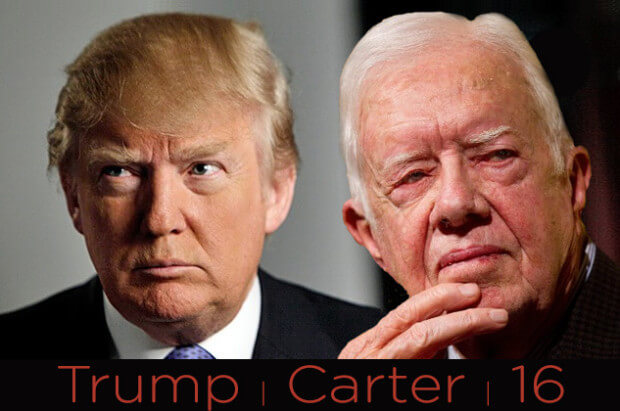
Every piece of evidence we have about the 2016 general election and the world around us points in the same direction: if nominated, Donald Trump would lose, and likely lose badly. The fact that Trump has defied expectations in the primary and survived numerous incidents (seemingly almost daily) that would end any other political career has given pundits and analysts an almost superstitious, gunshy awe of predicting failure for him – thus the “lol nothing matters” response you often get when you discuss both Trump’s obvious, glaring weaknesses and his pitiably weak standing in the polls. But the one straw commonly grasped by Trump supporters when confronted by the evidence is Gallup’s polling from early 1980 showing that Ronald Reagan was some 30 points behind Jimmy Carter, who of course he went on to demolish in the fall.
The Gallup 1980 polls are a weak analogy, for several reasons.
Continue reading This Is Not 1980, And Donald Trump Is Not Ronald Reagan
It Is Time For Marco Rubio To Join Ted Cruz For The Benefit Of Marco Rubio
RS: It Is Time For Marco Rubio To Join Ted Cruz For The Benefit Of Marco Rubio
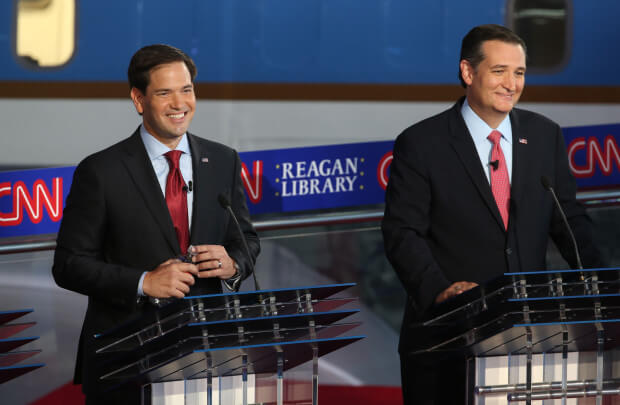
One of the important tests of character in politics is the willingness to stay and fight when the going gets tough, to stand your ground and be loyal to your supporters and your cause, even when the odds are against you, even when people are telling you to cut bait and go home. We know Marco Rubio has that fight in him; we’ve seen it before, from his underdog challenge to Charlie Crist to his comeback from the disappointment of New Hampshire to his upbeat push to continue fighting Donald Trump in Florida right now. But when people have invested their trust and their efforts in you, character and judgment also call for knowing when to stop fighting and cut a deal. The time for Rubio to do that is now – if not today, then no later than after Thursday’s debate. You have undoubtedly read many efforts in the past week by Cruz supporters, Trump supporters, Kasich supporter(s), liberals or anti-Trump party-unity Republicans to convince Rubio to get out of the race. But let me focus mainly on why striking a deal now to be Ted Cruz’s running mate would be in Rubio’s best interests, and is therefore something Rubio’s supporters should now actively desire.
Let’s start by taking stock of where Rubio’s career stands right now. His political talents are undimmed: his speaking skills, charisma, aspirational biography and message, and one of the most important attributes in politics, flexibility as a communicator to different audiences and in different settings. His favorable ratings remain sky-high with Republican voters, consistently the highest of anybody who ran in the 2016 field besides Ben Carson, and despite all the brickbats thrown at him on immigration, most polls until yesterday were still showing more Republican voters would be satisfied with a Rubio nomination than with any other candidate. His talents as a “closer” have been on constant display – through Super Tuesday, he was the best in the field at winning over late deciding voters. All of these things should continue to be true of Rubio in years to come, regardless of how the past week has gone. To the extent that Rubio is looking – as all politicians do, at least at his age – at his future, he should avoid throwing away the value of those assets.
The Next Campaign
On the other hand, Rubio has chosen not to run again for the Senate, so he will be out of work in January and out of elected office for the next two years unless he ends up as the Vice President. He could run for Governor or for another Senate term in 2018, but a Senate race would mean facing entrenched incumbent Bill Nelson, and if his eyes are on another national run in 2020, he’d be peppered with questions about whether he’s actually going to stick around and do the job. And if Rubio stays in this race just to focus on Florida and then loses Florida to Donald Trump – a very significant risk – he will find his standing in Florida politics significantly diminished, and face the possibility that his political career could be over at age 44.
Could Rubio run for national office again in the future? Republicans have a pretty long history of nominating candidates on their second or sometimes third try – Romney, McCain, Dole, H.W. Bush, Reagan. One of those candidates (Bush) did so from the springboard of being Vice President, and two others (Romney and Reagan) did so from outside public office, having spent four years planning their next run with no other real responsibilities to distract them. Romney in 2008 ran a campaign with some broad similarities to Rubio’s (despite their very different records), and dropped out immediately after Super Tuesday, resulting in Mike Huckabee passing him for formal “runner-up” status to John McCain. But with both McCain and Huckabee out of the running, Romney was able to consolidate his status as the frontrunner and get an earlier start raising money and endorsements four years later. If the GOP is out of power again after this election, Rubio could position himself to do that – but the longer he stays in this race bleeding support and potentially losing his home state, the more he will look diminished and overshadow some of the successes he’s had in this race.
But my argument here is not that Rubio should just slink away, but that he should use the leverage he has right now to cut a deal to be Ted Cruz’s running mate. Why should Rubio want to do this?
First, a VP deal keeps him on the trail and in the public eye in a way that an endorsement or quietly dropping out would not – while most of the other dropped-out candidates have vanished from sight, Rubio’s status as VP-nominee-in-waiting would ensure him more press coverage (especially for a role as attack dog against Trump) than the usual campaign surrogate. If Cruz is the nominee, it keeps Rubio on the national stage for the rest of 2016. That alone not only keeps him visible, but keeps him plugged in to a national network of donors, and allows him to build ties to Cruz’s superior campaign organization – all assets he could use in a future campaign even if 2016 ends badly. Sure, losing VP candidates have had a rough go in the past (aside from people like Mondale who had actually been VP, since 1900 only FDR became president after being the VP on a losing national ticket, although Bob Dole would come back to become Senate Majority Leader and a presidential nominee and Paul Ryan would become Speaker of the House), but Rubio is young and gifted and likely to avoid some of the differing pitfalls that did in figures as diverse as Sarah Palin, John Edwards, and Joe Lieberman.
Second, he could actually become the Vice President. That’s its own spot in the history books, and even if Cruz’s youth and clean ethical record mean there would be low odds of taking office mid-term, the VP job is not a bad one for guy with small children and a future. Cruz’s toxic relationships with Capitol Hill Republicans mean that a Cruz Administration would have great need for a good-cop ambassador to build bridges with Congress, a task Rubio is well-suited to, and unlike, say, John Kasich, he’s close enough philosophically to Cruz that he could expect to have a real role in the Administration and not just be the guy who goes to funerals. And Al Gore in 2000, Bush in 1988, Mondale in 1984, and Nixon in 1960 and 1968 all demonstrated the power that a sitting or former VP has in securing the nomination later on.
Could a Cruz-Rubio ticket win? I have argued throughout this campaign, and continue to believe, that Rubio would be the best general election candidate for the GOP, giving us the best shot to win the White House and defeat Hillary Clinton. As far as polling is concerned, that’s true even in the latest general election polls taken after Super Tuesday. I won’t belabor that point here, as it is no longer relevant to consider Rubio as having a shot at the nomination. But Trump is a truly terrible general election candidate, whereas Cruz at least polls mostly around even with Hillary, is a disciplined, energetic candidate with a good organization, and could keep the party together and have a puncher’s chance. Adding Rubio to the ticket could only help drive home the contrasts between the GOP and Hillary Clinton. Certainly, you couldn’t count them out.
Fourth, cutting a deal now squeezes out Kasich. Kasich appears to be running for the Vice Presidential job; his whole strategy is a brokered-convention strategy, but since he can’t possibly believe that a compromise between Cruz and Trump supporters would result in a Kasich nomination, the logical play would be to use his delegates as a bargaining chip to get a spot on the ticket. If Cruz announces that he’s chosen Rubio as his Vice Presidential nominee, it cuts the legs out of Kasich’s rationale for staying in the race (except to cut a similar deal with Trump), which in turn helps ratchet up the pressure on Kasich to quit, leaving Cruz the only anti-Trump game in town.
Rubio Can Get Better
What were Rubio’s weaknesses in 2016, that have led him to collapse after Super Tuesday? Let’s examine the list and consider which of them can be fixed in time to run again in the future. It turns out most of them can.
One, momentum. Through Super Tuesday, Rubio had won more votes than Ted Cruz outside of Cruz’s home state of Texas (24% to 22%), and more than three times as many votes nationally as John Kasich. But in the post-Super Tuesday states, Rubio’s support abruptly collapsed – aside from a landslide win in Puerto Rico, Rubio has dropped below 17% in the other eight post-Super Tuesday contests, falling to single digits and below even Kasich in Maine, Michigan and Mississippi (a geographically disparate enough group of states that it can’t be written off as just a bad local problem). He got just 10% of late deciders in Michigan, 4% in Mississippi.
But momentum by its nature is specific to a particular campaign; four or eight years later, all anybody will remember is that Rubio ran in a crowded field and was in the race pretty far.
Two, structure and timing. Rubio was never quite able to either get rid of Cruz and consolidate the conservative “lane” nor shake Kasich and consolidate the moderate/establishment voters, and before that he took too long shaking Jeb and Christie, which in turn delayed him in raising money and attacking Trump earlier. What if, what if, what if: the lament of many a losing campaign. But again, these are problems particular to 2016.
Three, a poorly run campaign. A variety of recent reports have illustrated what many of us suspected for a while: unlike Cruz, Rubio’s campaign was never as good as the candidate. He simply hired too many backward-looking veterans of the Romney campaign rather than innovators, and yet lacked the commanding financial advantages and consolidated “lane” to run a Romney-style primary campaign. But campaign teams can be replaced, and candidates can learn from the mistakes of past losses (even Ronald Reagan sacked his campaign manager on the day of the New Hampshire primary in 1980).
Four, youth and gravitas. Rubio had to work hard to overcome establishment-y voters’ preference for gray-headed proven executives like Jeb Bush, and his late flurry of sometimes very personal attacks against Donald Trump, while successful in getting inside Trump’s head, seem to have driven a faction of his supporters to Kasich, a Governor 20 years Rubio’s senior who talks about the 1980s and 1990s, high-mindedly refuses to criticize Trump, and styles himself as “the only adult in the room.” Polls have showed that one of the youthful-looking Rubio’s weak spots – even compared to Cruz, who’s the same age and a lot less experienced in office – is experience. Even if he doesn’t hold any more offices, the passage of some more time and the general sense that “this guy has waited his turn” can fix a lot of that.
Cruz Still Needs Rubio
The other factor for Rubio to consider is timing. I believe that – whatever the egos on all sides may say – if Rubio offered a deal today, Cruz would know he needs to take it. That may not be true forever, especially if Kasich wins Ohio, Rubio loses Florida, and Kasich wants to bargain.
Why I think Cruz still needs help is similar to why I argued all along that Rubio would run stronger one-on-one against Trump than Cruz would: because Cruz’s support is so heavily concentrated with Evangelical Christians and “Very Conservative” voters. We don’t have exit polls for March 5 or for Idaho or Hawaii (based on the map of Idaho, Cruz undoubtedly cleaned up with conservative Mormons last night, previously a likely Rubio stronghold), but let’s update the charts I’ve been using of each candidate’s strength across these groups:
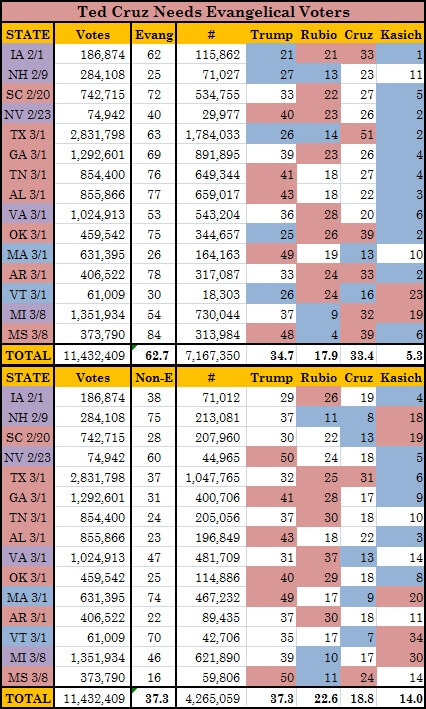
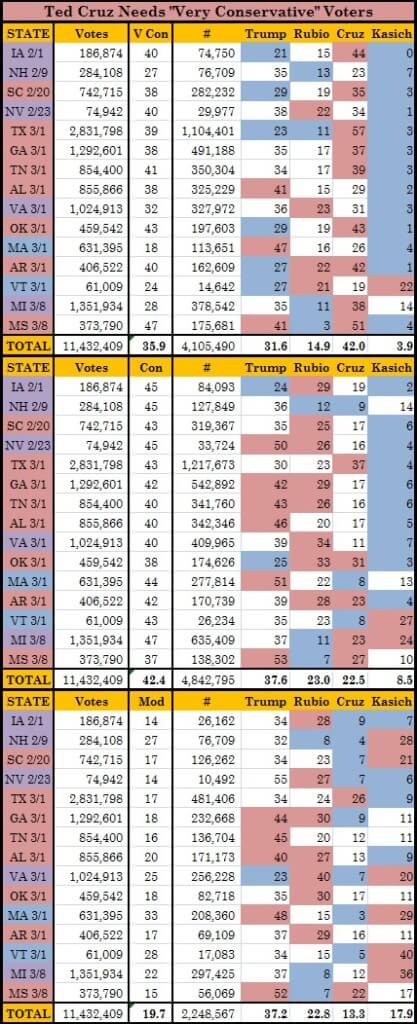
As you can see, Cruz improved a bit last night, but he remains very, very dependent on his two overlapping core groups, both of which are likely to get a lot scarcer as we run out of Southern and other deep-red states as the calendar moves forward. (Also, Cruz doing well with Mississippi “moderates” is a bit like when Kasich did well with “Very Conservative” Vermonters – it may just be a regional difference in defining the spectrum). His biggest risk if Rubio gets out is that the more moderate Rubio supporters will drift off in increasing numbers to Kasich, and the exit polls from Michigan in particular suggest that is a threat Cruz can’t lightly ignore. Having Rubio out on the trail making an explicit stop-Trump party-unity pitch can make a big difference in finishing off Kasich and keeping wavering Rubio supporters dedicated to the unity ticket. The announcement of such a ticket – highly unusual in a primary campaign – would itself be a major news event that would dominate discussion for days, and would have a galvanizing effect on the morale of anti-Trump Republicans who are now so consumed with fighting each other over who should and shouldn’t drop out.
In short, there is every reason – looking strictly from the perspective of the self-interests of all the players – why it would make sense by the end of this week for Rubio to cut a deal to become Cruz’s running mate, and for Cruz to make that deal.
Marco Rubio’s Path To Victory After Super Tuesday, By The Numbers
RS: Marco Rubio’s Path To Victory After Super Tuesday, By The Numbers
Mister One on One
Super Tuesday ended up not being quite so super for anyone in the GOP primary. Donald Trump was supposed to break out and put the race away, and instead lost 4 states, won 3 more by narrow margins, and looked very much like like a beatable frontrunner, including a 17-point thumping in the biggest state in play. Ted Cruz saw his “SEC firewall” melt, finished third with fewer votes than Marco Rubio across the South, and faces a long march into far unfriendlier territory. Rubio narrowly lost Virginia after staking much of his Super Tuesday campaign on staging yet another of his furious late comebacks there, got clobbered in the delegate race even in states where he got a lot of votes, and generally continued his pattern of closing well without quite putting away his opponents. John Kasich lost his shot at his first primary win, losing Vermont by 2.3 points, and finished dead last behind Ben Carson in 7 out of 11 states. And Carson, despite finally cracking the elusive 10% barrier in two states, won delegates only in Virginia and was finally compelled to conclude he must drop out.
Let’s take a look at the lessons of Super Tuesday, as well as what they tell us about the GOP’s best choice for consolidating behind a single anti-Trump candidate, which now seems as if it will not happen until after Armageddon Tuesday on March 15. I continue to believe, for reasons both quantifiable and unquantifiable, that Marco Rubio is the best man for the job.
Marcomentum, Big Texas and the Anti-Trump Turnout Boom
All the talk heading into Super Tuesday was about Donald Trump’s “ceiling”: would he remain stuck at about a third of the vote, as he was in the first three states, or would he start cracking the 40% thresholds that signalled a “jailbreak” of follow-the-frontrunner voters to Trump?
Trump did manage to hit full jailbreak status in two states, Massachusetts (49%) and Alabama (43.4%), and perhaps more distressing to the anti-Trump forces, got close in two other states whose politics are less of a one-party cesspool, Tennessee (38.9%) and Georgia (38.8%). But his overall share of the vote was 34%; in five states he fell below a third of the vote (Arkansas, Vermont, Oklahoma, Texas and Minnesota), in the last three of those below 30%. Of his seven wins, three were by fairly close margins of victory:
Virginia: 34.7% to Rubio’s 31.9%, a margin of 28,918 votes. John Kasich, who finished fourth, drew 96,519 votes in Virginia (9.4%), and Ben Carson, who finished fifth, got 60,093 (5.9%); it’s not hard to see that the minor candidates made the difference, especially Kasich, whose appeal is so different than Trump’s (Kasich is pitching to voters who are both ideologically and temperamentally moderate, while many of Trump’s voters are the former but few are the latter).
Arkansas: 32.8% to Cruz’s 30.5, a margin of just 9,271 votes. Carson, who finished fourth, got 23,173 votes (5.7%), while Kasich got 15,098 (3.7%). Again, even before you discuss the Rubio/Cruz divide, it’s clear that the minor candidates were a drag on the anti-Trump movement.
Vermont: 32.7% to Kasich’s 30.4%, a margin of 1,424 votes. Carson, who finished fifth, got more than that – 2,544 (4.2%).
So on top of the four states where he was beaten, including a 17-point loss to Cruz in Texas and a 15-point loss to Rubio in Minnesota, Trump has hardly put this race away. If you could combine the Rubio and Kasich votes and the Cruz and Carson votes, Super Tuesday would have looked like this:
Texas: Cruz 47.9%, Trump 26.7%, Rubio 22.0%
Oklahoma: Cruz 40.6%, Rubio 29.6%, Trump 28.3%
Arkansas: Cruz 36.2%, Trump 32.8%, Rubio 28.6%
Alaska: Cruz 47.3%, Trump 33.5%, Rubio 19.2%
Virginia: Rubio 41.3%, Trump 34.7%, Cruz 22.8%
Minnesota: Rubio 42.4%, Cruz 36.3%, Trump 21.3%
Vermont: Rubio 49.7%, Trump 32.7%, Cruz 13.9%
Georgia: Trump 38.8%, Rubio 30.0%, Cruz 29.8%
Tennessee: Trump 38.9%, Cruz 32.3%, Rubio 26.5%
Alabama: Trump 43.4%, Cruz 31.3%, Rubio 26.5%
Massachusetts: Trump 49.3%, Rubio 35.9%, Cruz 12.2%
If we had those results, all the talk Wednesday morning would have been about a Trump collapse. Now, obviously you can’t just allocate the minor candidates’ support like that going forward – some will go unpredictably between Rubio and Cruz, some to Trump, and – this is important to remember – some will just stay home, because they were just personally loyal to Ben Carson or because Kasich is selling a pure-moderation message that none of the other candidates are selling. It is probably the case, for example, that a good number of Kasich’s New England open-primary independent supporters would just not have voted in the Republican primary if the choices were Trump, Cruz or Rubio; a significantly higher percentage would probably have skipped it if the choices were just Trump and Cruz, given how many Kasich-style moderates regard both of them with roughly equal horror. But as Sean Trende has demonstrated with a deep dive into the exit polls I won’t rehash here, the demographic profiles of Kasich and Rubio supporters in this race are pretty closely aligned, as are the demographic profiles of Cruz and Carson supporters. Leon made the same point this morning in sketching out what Cruz would need to do in order to be the anti-Trump candidate.
Also, for all the talk about Trump driving the record-breaking turnout we’ve seen in state after state so far – Vermont and New Hampshire are the only states where turnout wasn’t up at least 20% from 2012 – there is another side to the story: in the 11 Super Tuesday states, even if you don’t count a single vote for Trump, turnout was 119.1% of 2012 turnout in those states (thus, up 19.1%); across all 15 states to vote so far, the figure is 113.3%. That’s partly due to a turnout boom for favorite son Cruz in Texas (up 43.1% without Trump voters) and significantly due to having a contested election in Virginia, where Mitt Romney’s opponents failed to make the ballot in 2012 (up 151.9%). But anti-Trump – or at least non-Trump – turnout has been greater by itself than 2012 turnout in six other states as well: Iowa (+16.4%), Nevada (+22.9%), Oklahoma (+15.1%), Arkansas (+79.4%), Minnesota (+81.5%) and Alaska (+10.6%). Whether those are voters coming out because they want to stop Trump or because they are excited by his opponents, that’s great news for the GOP’s chances of surviving Trump’s attempt at a hostile takeover.
Another sign that Trump can be taken – but that time is starting to run short – is that yet again, he fared relatively poorly among late-deciding voters. On the other hand, he did not do as poorly with late deciders as he did in Iowa or South Carolina, and he actually won them in Massachusetts and Alabama, as he had in New Hampshire), leading to his jailbreak wins there. Rubio, meanwhile, remains easily the best closer in the bunch: he’s now won late-deciding voters 7 times, winning them by double-digit margins in Nevada and Virginia and beating Trump by double-digit margins in Iowa, South Carolina, Oklahoma and Arkansas. Cruz won late deciders in Texas and Tennessee, Kasich in Vermont:

Note that we don’t have entrance/exit polling for Rubio’s win in Minnesota or Cruz’s in Alaska, both caucus states.
The late charge accounts for Rubio’s fairly persistent overperformance of his polls:
Rubio outperformed his RCP average in Minnesota (14 points), in Virginia (10 points), in Oklahoma (5 points), in Arkansas (2 points), in Vermont (2 points), in Tennessee (2 points), and in Georgia (1.5 points).
That’s reason to be optimistic about Rubio going forward as the standard-bearer of the anti-Trump faction, but it’s also worrisome how far ahead Trump has been with the two-thirds or so of the electorate in each state that decided their votes more than a week in advance (Cruz in Texas is the only candidate besides Trump to win early deciders, and the massive size of his lead with them suggests that perhaps Rubio would have been wiser not to bother contesting Texas, where he got over half a million votes and 4 delegates).
Geography
The good news for Rubio is that yet again, he proved the breadth of his appeal across the map. He continues to be the only candidate besides Trump who is running a 50-state campaign. With all the votes counted aside from a few very late precincts in Arkansas and Minnesota, we can see that outside of Cruz’s home state of Texas, Rubio got 114,000 more Super Tuesday votes than Cruz did – 1,373,308 votes at last count (24.0%) to Cruz’s 1.258,940 (22.0%). That’s swamped by Cruz’s big showing in his home state, where he got nearly as many votes (1,239,158) as Trump and Rubio combined (1,259,669), such that if Trump ends up with the nomination, Texas Republicans may be printing “Don’t Blame Me, I’m From Texas” bumper stickers, and justifiably so. But it underlines the extent to which Ted Cruz depends on a particular type of voter that may be harder and harder to find in the states ahead of him than the states behind. Texas really is different.
Let’s break down the voting so far by region, grouping states that may have something politically in common. The largest region to vote so far is the South, the states below DC and east of Texas: Virginia, South Carolina, Georgia, Alabama, Tennessee and Arkansas. This region is now pretty far into being done voting; Louisiana votes March 5, Mississippi and Kentucky on March 8, Florida, North Carolina, and Missouri March 15, and only one culturally quasi-South state left after Armageddon Tuesday: West Virginia May 10.
Then we have the Southwest, of which Texas and Oklahoma voted on Tuesday; Arizona votes March 22, New Mexico on June 7 at the very end.
New England is three states in – New Hampshire, Massachusetts, and Vermont – with Maine voting March 5 and Rhode Island April 26.
Two Upper Midwest states have voted, Iowa and Minnesota, both caucus states; Wisconsin votes April 5.
Two states in the West have voted, Nevada and Alaska, both caucus states; Hawaii votes March 8, Oregon May 17, Washington May 27, and California June 7.
The other regions aren’t in play yet:
The Great Plains states start March 5 in Kansas, followed by North Dakota on April 1, Nebraska May 10, and South Dakota June 7.
The Atlantic Northeast states, DC on March 12 and then New York April 19, Pennsylvania, Maryland, Connecticut and Delaware April 26.
The Mountain states were supposed to begin Super Tuesday, but Colorado cancelled its voting and Wyoming pushed back its delegate selection to March 12; Idaho kicks off March 8 followed at long intervals by Utah March 22 and Montana June 7.
The territories start March 6 in Puerto Rico, and the others (all small) vote between March 12-19.
And of course the Midwest, which begins with Michigan March 8, Illinois and Ohio march 15, Indiana May 3. Along with the Northeast, California and Florida, the Midwest is highly likely to decide the nomination.
So how have the candidates fared in these regions?
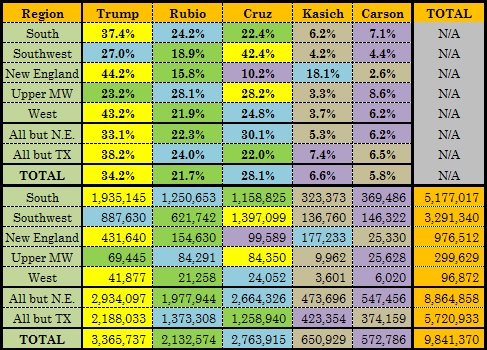
Cruz’s entire popular vote lead over Rubio consists of his margin in Texas. He has cleaned up two states in the Southwest, but Arizona is the only big delegate prize left there, and Rubio just snagged the endorsement of New Mexico Governor Susanna Martinez.
If you had told me a few months ago that Rubio would get nearly 100,000 more votes than Cruz in the South, I’d have been sure that we’d be talking today about the Cruz campaign in the past tense. Rubio finished well ahead of Cruz in Virginia, and beat him very narrowly in South Carolina and Georgia. That was largely due to Trump eating into what was supposed to be Cruz’s voters, killing Cruz’s plan for an early knockout blow. Of course, this primary season has laid waste to a lot of plans (both Cruz and Rubio at various times floated the idea of South Carolina being a critical early win), and here we are. The March 5-15 states left in the South will likely go a very long way towards determining which of Rubio or Cruz stays in this race to the end.
Cruz also pulled just slightly ahead of Rubio in the Upper Midwest, by 59 votes pending the final vote tally in Minnesota, so that’s more or less a wash. We have not yet had a primary in the Upper Midwest, although Wisconsin is more similar to Minnesota than to Iowa, and the last two Marquette polls had Rubio running a little ahead of Cruz but Trump starting to widen his lead.
On the other hand, boding poorly for Cruz’s ability to go national, he has been a complete non-factor in the New England states, whereas Kasich – who has finished behind Ben Carson in 9 of the 12 states outside New England – has won just 5.3% of the vote outside those states and 3.3% in the Upper Midwest despite being the most Midwestern guy in the field.
The West is the hardest to figure, since we have two small, oddball caucuses to work with, one of which (Nevada) was dominated by the fact that Trump owns a huge Vegas casino and is one of the state’s most prominent employers.
The geographic case for Rubio is simply that he’s the only guy besides Trump who doesn’t have to write off any regions. The downside of that, so far, is that in a divided field he’s been stretched thin in ways that don’t help him accumulate delegates; in South Carolina, Texas and Alabama he got a combined 827,633 votes (22.3%, 17.7% and 18.6%) and got a grand total of 5 delegates to show for it, because South Carolina was winner-take-all and Texas and Alabama had 20% minimum thresholds for getting any statewide proportional delegates. Rubio got more actual votes in Georgia than Cruz, but lost the delegate race to him there, 18-14. He could face the same situation in Louisiana, if the early polling is suggestive (it may not be).
Demographics and Ideology
Let’s return to a point I made in the wake of South Carolina: Ted Cruz’s success in the early states has been really, really, really dependent on (1) Evangelical Christian voters and (2) self-described “Very Conservative” voters. And neither of these groups is likely to be anywhere as prevalent once we get past March 5.
Here’s a weighted average (by the size of each state’s vote) of what the exit polls show us about Cruz’s dependence on Evangelicals, highlighting in the third column the % of each state’s voters who were Evangelical in the exit poll samples (again, we have no exits for Minnesota or Alaska):

That looks pretty lopsided – Cruz runs about even with Trump with about a third of Evangelical Christians, with Rubio drawing a little under 20% and Kasich a rounding error. Among non-Evangelicals, however, Rubio runs six points ahead of Cruz, who drops to a little over half of Trump’s vote, and Kasich draws the difference between Rubio and Trump.
But wait! You will notice that there was one very large group of non-Evangelicals Cruz did manage to do well with: Texans, who gave their hometown hero 31%. (I should note that even if he doesn’t win the nomination, Cruz’s powerful showing in the Texas primary should deter anyone from challenging him in 2018 on the theory that Texans might have soured on him). If you look at the 12 states outside Texas where we have exit polls, Cruz only cracks 20% of the vote in one of them (Alabama – which among the 9 states where the exit poll question has been asked so far, is the only one where more voters would prefer deporting illegal immigrants to ‘amnesty’).

While Cruz supporters may object to separating out Texas, the simple fact is that the pattern is really consistent outside Texas, and Texas only votes once. In the rest of the states, he barely runs ahead of Kasich with non-Evangelical voters, and runs more than 10 points behind Rubio, while Rubio runs only 4 points behind Cruz with Evangelicals. Plus, he does even worse with non-Evangelicals in non-Southern states, even border-South states like Virginia. Cruz simply has not solved this problem, and given Trump’s strength outside of the Evangelical vote, it would seem rather risky to pick Cruz as the chief vessel for the anti-Trump vote headed into a whole bunch of states where his core voting bloc is a lot smaller part of the electorate (sort of like how Bernie Sanders ran into a completely predictable buzzsaw when he got out of states with an overwhelming number of white liberals):

If you’re wondering, those numbers probably do understate the Evangelical vote a bit – comparing the projections I drew on for my last post to actual results:

That’s good news for Cruz, but it may not be enough – massive Evangelical turnout helped him pull away from Rubio in Tennessee, Alabama, and Arkansas, but still didn’t carry him to victory against Trump.
Then there’s the ideological splits, with Texas:

…and without Texas:

It’s the same pattern: Cruz did vastly better with “Somewhat Conservative” and Moderate voters in Texas than in the other 12 states, and when you back out Texas, you see that Ted Cruz voters are from Mars, John Kasich voters are from Venus…and Rubio occupies the sweet spot in the middle (a nicely habitable planet), beating Kasich with the moderates (where Cruz is in single digits), getting about half of Cruz’s vote with the Very Conservative voters (where Kasich is roadkill), and getting more of the largest group – the Somewhat Conservative voters – than Cruz and Kasich combined. And outside Cruz’s 57-23 margin in Texas, he only beats Trump by a point among the one group he has to depend on.
Cruz has unsurprisingly done best in states where Very Conservative voters are around 40% of the vote – his wins have come in Iowa (40%), Texas (39%), Oklahoma (43%) and Alaska (no poll). Among the upcoming states for which we have 2012 exit polls from contested primaries/caucuses (i.e., before Santorum dropped out and effectively ended the race), most of them will have more moderate electorates. Share of Very Conservative voters, 2012 exit polls:
Louisiana 49%
Mississippi 42%
Arizona 34%
Florida 33%
Ohio 32%
Wisconsin 32%
Michigan 30%
Maryland 30%
Illinois 29%
Again, these are mostly not good numbers for Cruz, even assuming a bit of an upward shift.
Completing the exit picture, let’s look at party self-ID, bearing in mind that this may vary from actual registration (even closed primaries like Oklahoma feature people who don’t call themselves Republicans:

…and without Texas:

You can see once again that Cruz’s candidate profile looks quite different in Texas than everywhere else. His showing with independents varies a lot because, well, Massachusetts independents are pretty moderate, whereas, say, Nevada independents trend libertarian. Closed primaries are likely to hurt Trump, as Neil Stevens showed in detail earlier today, but it’s far from clear that they help Cruz more than they help Rubio. What is clear is that they starve Kasich of oxygen; while he did well with Republicans in Vermont and passably in New Hampshire and Massachusetts, his ability to even appear on the map in places like Virginia, South Carolina and Georgia depends on independents. Which also suggests that Kasich’s inevitable departure from the race may not leave a whole lot of voters on the table in the 26 (out of 40) remaining contests with closed primaries or closed caucuses.
Conclusion
Many of us had hoped that Super Tuesday would winnow the field a good deal more, because Trump’s success thus far has depended on a divided opposition, and the longer he can sustain that (as Romney did in 2012), the more he builds the psychology of a winner. It now looks as if that will have to await Florida and Ohio on Armageddon Tuesday, unless something really surprises us before then. As Phil Klein has illustrated, the calendar slows a lot after that, giving the remaining contender(s) a lot more time to pound Trump, slow his march to 1,237 delegates, and possibly either get their themself or (much more likely) throw this to a contested convention where the party will have a final chance to come together and save itself from Trump and certain defeat.
Rubio will – as he has on several occasions – now have to prove himself again, starting Saturday (where Kansas may be his best bet, although we have little useful polling, and Rubio is further ahead of Cruz in the one poll we have for Kentucky) and running through Florida. But on the morning of March 16, we’ll be looking once again for an opportunity to end Trump’s ability to win with 34% of the vote. It won’t be easy to convince two of the three candidates to leave, and it may be especially challenging for Rubio to do because playing chicken, not making deals and frustrating the Republican Party are three of Ted Cruz’s favorite pastimes. Which is why Rubio will really need to put on a convincing showing that his ability to compete in more places and with more groups than Cruz is a vital asset.
The case for Rubio being the guy who can ‘unite the clans’ and beat Trump is fairly straightforward: Cruz has no record of competing for the Kasich voters (or the similar voters who make up a faction of Rubio’s base), and Kasich has no prayer of getting Cruz’s voters. Cruz abandons blue areas like New England and probably a lot of the Northeast; Kasich abandons most of the rest of the country other than Ohio. Rubio fights everywhere. Cruz’s argument is that a lot of his voters, but not Rubio’s, would go to Trump – but as with the Carson voters, voters who are released from the guy they were backing are apt to be persuadable, and Rubio has the best record of closing well with late deciders, and would benefit from staging a one-on-one race where (as has only just happened since Nevada) some serious fire is concentrated on Trump. And certainly Rubio can present a very vivid contrast to Trump.
The theme of Trump’s campaign has been his ability to avoid a one-on-one race. The theme of Rubio’s, as in his 2010 Senate race, has been all his opponents’ fear of the potential of finding themselves one-on-one with him.
It’s still the best way to beat Trump: rally around one guy who can play on the whole map, with the whole party.
New CNN Poll: Trump Loses To Hillary, Rubio & Cruz Would Win
A Vote For Trump is a Vote For Hillary Clinton: Why Trump Is A Sure Loser
RS: A Vote For Trump is a Vote For Hillary Clinton: Why Trump Is A Sure Loser
Do Not Choose To Lose
Sometimes, losing is a choice. And if the Republican Party nominates Hillary Clinton donor and Clinton Foundation donor Donald Trump to be its presidential candidate, the choice to lose to Hillary will already have been made, and the only question will be how to manage the scale and collateral consequences of the defeat. Nobody should go to the polls Tuesday under the delusional impression that a vote for Trump is anything other than a choice to ensure that Hillary Clinton is the 45th President of the United States.
Let us count the ways. For simplicity, I’ll just compare Trump vs. Hillary Clinton to Marco Rubio vs. Hillary Clinton to illustrate why Trump would fail in a great many situations where Rubio would succeed. But a similar analysis would show, if for slightly different reasons, why Rubio would run better against Bernie Sanders than Trump and why Ted Cruz or one of the two pretend GOP “candidates” would run better than Trump against either.
This analysis will look at three factors. First, I’ll walk through the numbers, the polling we have so far. Second, I’ll offer some analysis of why we should not discount what the polling is telling us. And third, I’ll look at the structural differences between a primary and general election that will make it prohibitively difficult for Trump to translate a primary win into a plausible general election campaign.
Head-to-Head National Polls
Head-to-head general election polling during primary season is not the most reliable of indicators, but since we obviously can’t get post-primary polls until the primaries are over, it’s all we have in terms of polling evidence, so it’s as good a place as any to start. Here’s where the national general election polling averages stood as of this weekend:
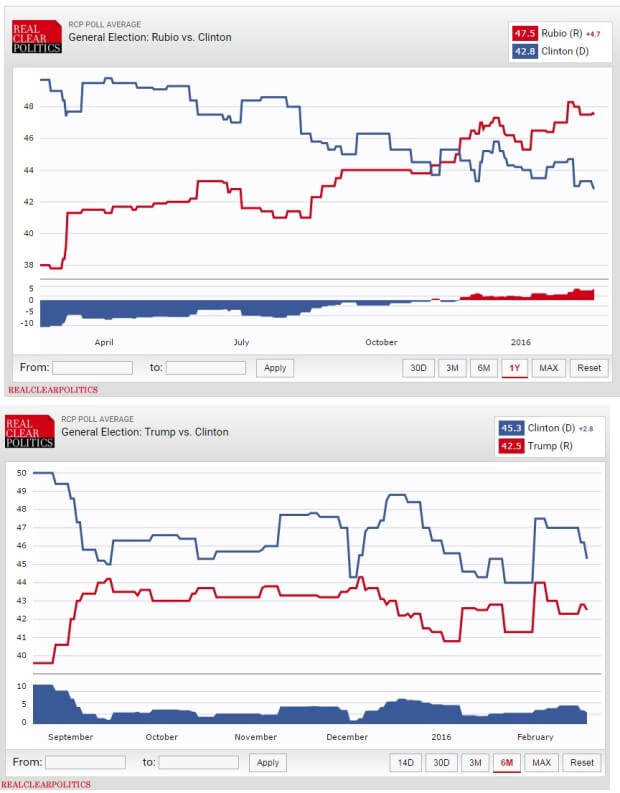
You will notice not only that Trump trails Hillary by almost 3 points while Rubio leads her by almost 5, but also that Rubio has been steadily gaining ground on Hillary – he leads 12 of the last 14 polls (Hillary leads by 1 in the other two) and 15 of the last 20. Trump, by contrast, is flat-out lying when he claims to lead Hillary in every poll – out of 45 polls in RCP’s database, Trump leads Hillary in only 5, is tied in 2 others, and trails in 38 of them. Of 18 polls taken since late November, 9 show Hillary at 48 or higher; only two show Trump at 47% and one at 46. The only real variation is that some polls show more undecideds than others.
HuffPost Pollster collects a slightly different but substantially overlapping sample of polls – we can debate which is a better resource, as the HuffPost people let in a wider range of fringe-y partisan and online polls, but you should not just automatically disregard their data just because HuffPo is a left-wing website; it’s the same general world of polling. Anyway, it reaches similar conclusions to RCP throughout this article, only with different numbers. HuffPost sees Trump as decisively behind Hillary right now:
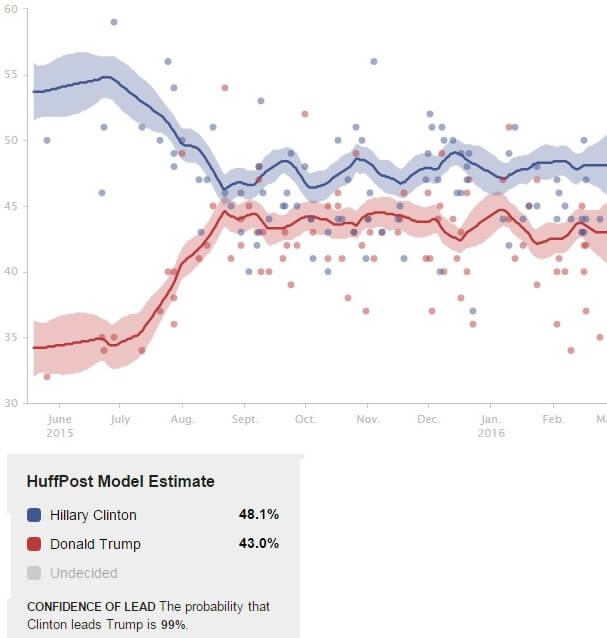
Whereas HuffPo estimates Rubio would start the general election slightly ahead of Hillary, and it is worth noting that HuffPo has Rubio ahead of Hillary in 6 of the last 7 polls, but Hillary up 10 points with 20% undecided in the one Morning Consult poll going the other way:
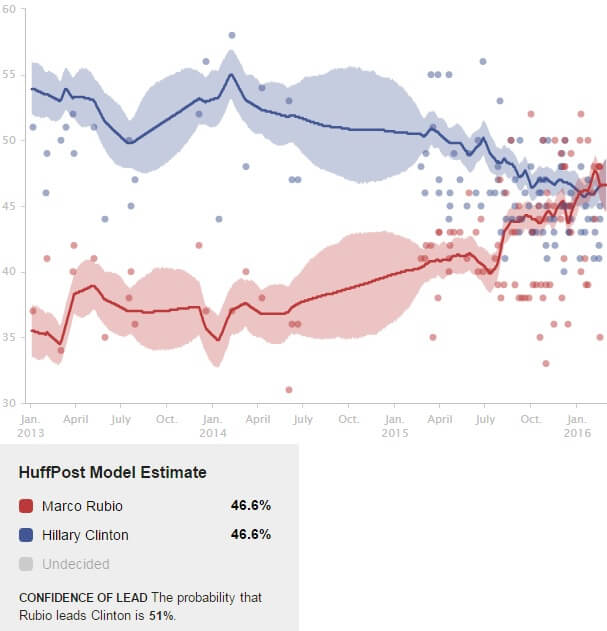
Favorability Polls
Besides head-to-head matchups, an early polling indicator to watch is favorable vs unfavorable ratings with voters, or “fav/unfav”. The more unpopular a candidate is, the harder it is to come back with undecided voters.
RCP has Trump’s fav/unfav at 34.4 favorable, 57.8 unfavorable (-23.4), so far underwater that it would be nearly impossible to win. How bad are Trump’s numbers? Barack Obama at this point in 2008 was at 69.0 fav/23.0 unfav (+46). Mitt Romney was actually in positive territory when he lost in 2012 (49.4 fav/44.6 unfav, +4.8), and never saw his unfavorables go above 51% in any poll the entire 2012 cycle; Romney grew from +7.6 in late January to +11 by the end of the primaries before the general election onslaught ground him down. John McCain was at 52.3 fav/41.5 unfav (+10.8) on Election Day 2008, and was around +20 at this juncture. Trump would undoubtedly see his favorables driven down during the general election campaign, just as Romney’s and McCain’s were, but he’s starting in a hole far deeper than the worst day of either of their campaigns. By this measure, Trump makes McCain and Romney look like Ronald Reagan on steroids.
In fact, Trump’s backsliding has been going on a while already. Trump’s favorables were getting better for a few months after he got in the race, as a faction of Republicans warmed to him, but they have been deteriorating in polls taken in December and January (RCP doesn’t have more recent ones than that). HuffPost likewise has Trump 20 points underwater, and steadily so for months:
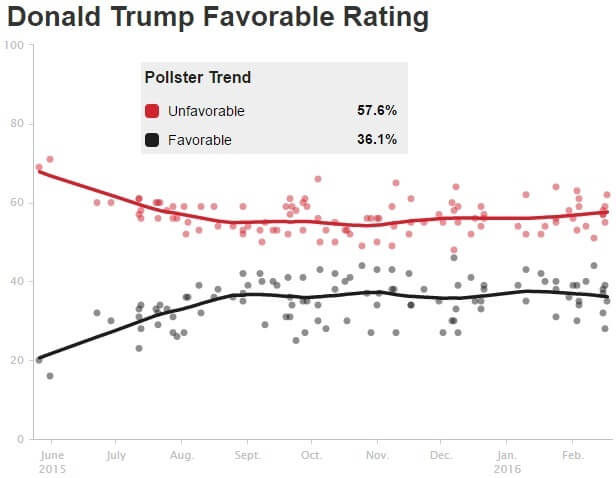
Gallup, in a January poll, found that Trump – if nominated – would have the most unfavorable rating of any nominee from either party in the quarter century since it started polling the question, unfavorables on par with George W. Bush at the lowest point of his presidency. 60% viewed Trump unfavorably in Gallup’s poll, worse than George H.W. Bush a month before he got 38% of the popular vote in 1992. If you are keeping score at home, 60% of the people disliking you makes it hard to get 50% of them to vote for you.
Rubio, in RCP, has seen much more volatile favorables with the general electorate, and is presently at 35.2 fav, 38.0 unfav (-2.8), a little underwater but with a whole lot of people not sure yet. HuffPost likewise shows a lot of Americans still not settled in the kind of negative views they already have of Trump:
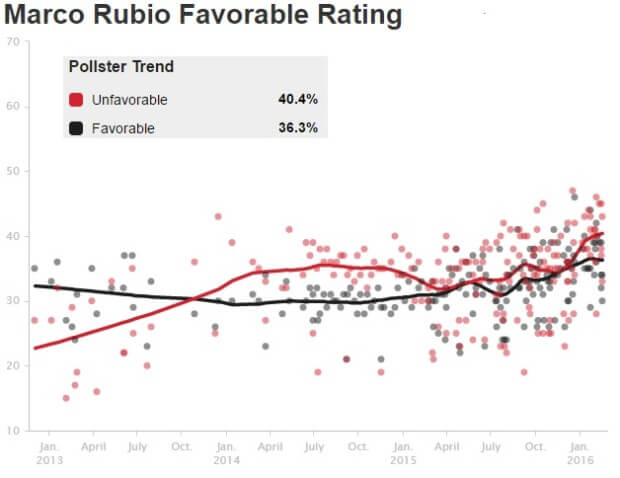
On the whole, everybody’s favorables (except Bernie Sanders) are lower now than everyone’s in 2008, but Rubio still looks a lot healthier than Trump. And there are a lot of subsets of voters at the margins where this gives Rubio room to win votes in the general election that are already closed off to Trump – as I noted a few days ago, Rubio actually has positive favorables with Hispanics nationally, while Trump is hated and seen as offensive by over 70% of them. College-educated voters would likewise be closed off to Trump; a mid-February Quinnipiac poll had Rubio at 46-40 (+6) with college-educated voters nationwide, Trump at 29-66 (-37), and trailing Hillary 52-37 with college-educated voters, who even in the GOP primaries so far have been a majority of the electorate.
Nate Silver did a deeper dive on this in mid-January, noting that Gallup found Trump at +27 with Republicans (compared to Rubio at +46), -27 with independents (compared to +4 for Rubio) and -70 (!!!) with Democrats, compared to -27 for Rubio. Silver, using the HuffPost Pollster database of polls, generated an average over the whole November-mid-January period and found Trump the most unpopular GOP candidate with the general electorate:
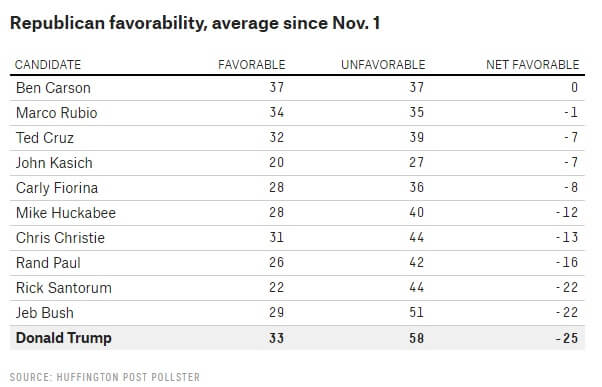
In fact, the most recent Gallup poll released February 29, 2016 shows Trump’s net favorables with Republicans down to +15, half what it was a month ago and his lowest since Gallup started tracking in early August. The grind of the primary campaign had also dropped Ted Cruz’s favorables – but not Rubio’s, which stood at +34, a bit lower than his campaign-long average but the same as it was when the year began.
Meanwhile, RCP has Hillary plenty unpopular, at 42.2 fav, 51.4 unfav (-9.2), and she has deteriorated badly from being almost even in the spring and summer. Huffpost illustrates the crash:
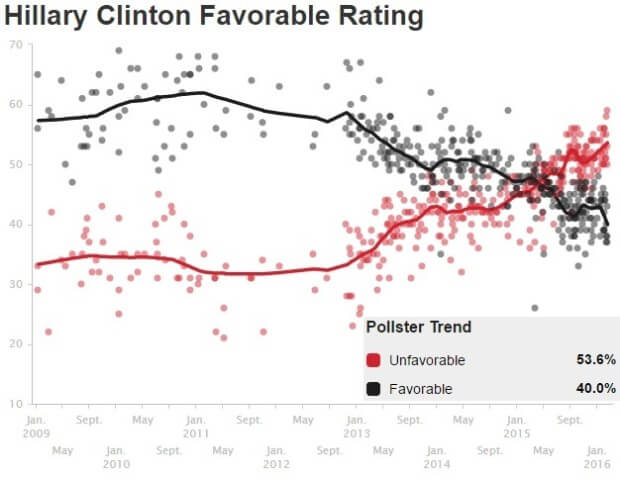
Compared to Rubio, that’s the picture of an extraordinarily vulnerable candidate, even before you consider the historic trends working against the Democrats. But replace Rubio with a candidate whose negatives are as deeply underwater as Trump, and suddenly Hillary looks pretty safe.
Head-to-Head State-By-State Polls
Ideally, since Presidential elections are conducted at the state rather than national level, we could supplement our national polling with robust state-by-state poll averages. That’s what we’ll have to work with as the general election warms up, but for now, only a handful of states have been polled for general election matchups, and most of those only once or twice, in some cases not since November or earlier (Missouri was last polled in August) and in one case (Pennsylvania) the most recent Rubio vs. Clinton matchup is from February, while the most recent Trump vs. Clinton matchup is from October. So take all these with a grain of salt.
That said, the evidence we have from the state-level polling is consistent with the national polling: Rubio runs well ahead of Trump, winning states Trump loses, keeping close in states where Trump gets blown out. Of the 13 ‘battleground’ states where we have polling for both candidates, Rubio runs better than Trump in 11 of them, eight of those by 5 points or better, three by double digits (including New Hampshire, where Trump beat Rubio by 24 in the primary – a reminder that primary pluralities and general election majorities are two radically different things). Oddly enough, one of the two states where Trump polls better than Rubio is Rubio’s home state of Florida, but then only by a single point; Georgia is the only state where Trump would run significantly better, although both would start at 48% of the vote. Trump would enter multiple battleground states polling below 40%, consistent with his massive unfavorables.
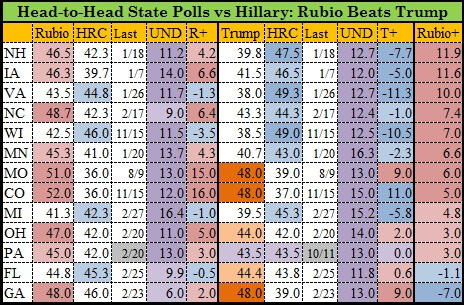
(Yes, I realize it’s exceptionally unlikely that the Q Colorado poll is correct that Hillary would lose Colorado by double digits to either Rubio or Trump. The point here is how they stack up in an apples-to-apples comparison in the same polling environment).
Trump claims he would put his home state of New York in play. We have one poll of New York, a Siena College poll from early February that shows Hillary up 57-32 on Trump, with Trump’s fav/unfav at 25/71 unfav (-46). Rubio would likewise lose New York to Hillary, at 54-37, and his unfavorables are 34/45 (-11), but Rubio isn’t the one running around claiming he would be competitive in a home state where 71% of the voters disapprove of him. You can safely repeat that for most any other blue state you like.
#NeverTrump Polls
A key problem Trump faces is the threat that a lot of Republicans (myself included) simply won’t vote for him in November. This, too, is a hard thing to measure at this juncture – when emotions are running high in a primary, it’s not that unusual to see people swearing they won’t vote for the nominee, then coming home in the fall. On the other hand, as Silver reminds us, the high levels of party loyalty we have seen in the last four elections are something of a historical anomaly – it was a frequent occurrence from 1952 to 1996 to see nominees of both parties who lost 20% or more of their own party’s voters in November, either through aisle-crossing or to third party candidates (Ross Perot, George Wallace, John Anderson). Of course, a major reason for that is an ideologically polarized electorate, which Trump would alter given his long record as a big-government social liberal. But I’m getting ahead of myself. First the numbers – since we don’t have poll averages, we have to go poll by poll.
Bloomberg Super Tuesday Poll: A Feb. 22-24 online poll of GOP primary voters in the Southern Super Tuesday states (Alabama, Arkansas, Georgia, Oklahoma, Tennessee, Texas, and Virginia) only two of which (Virginia and Georgia) are typically competitive in a normal general election these days. Trump has a 60/37 (+23) fav/unfav in this poll, compared to 65/28 (+37) for Rubio, an overall 37-20-20 lead on Rubio and Cruz, and a 48-44 lead in a hypothetical two-way matchup with Rubio. But in a vaguely worded question, 20% say they would “never” vote for Trump, and another 14% aren’t sure (only 10% would never vote Rubio, although 20 are unsure, numbers much more in line with soft disapproval from voters who would mostly come home in November). When given a choice between Trump and Hillary, 27% would not vote for Trump (9 for Hillary, 14 for a third party, 4 would stay home) and another 6% were not sure. That means only two-thirds of GOP likely primary voters in a set of mostly deep-red states would prefer Trump to Hillary. That’s an enormous red flag.
Democracy Corps poll: A poll by a Democratic firm hunting for opportunities, so these are results after some push-polling to see what Democratic messages worked with a “likely voter survey of 800 Republican base voters was conducted online using a voter file sample. The results were weighted to match Democracy Corps’ national likely voter data set for self-identifying Republicans and Republican-leaning independents who will vote in the Republican primaries or caucuses.” The poll shows that 20% of the Republican base could be induced to desert Trump in the general election, and indeed that self-identified moderates (even though they’re the group containing the most Trump supporters) would give just 60% of their votes to Trump against Hillary compared to 83% for Rubio:
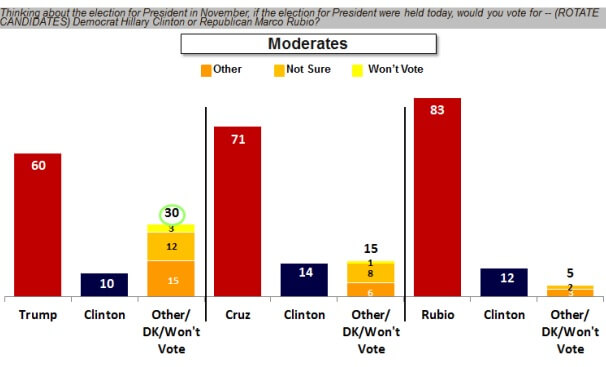
The survey found that Evangelicals were not likely to desert Trump, but Tea Partiers, Moderates and Observant Catholics (the other three segments in the poll) were, depending on the anti-Trump messages tested – “[t]he strongest attacks on Trump charge that he is an ego-maniac who cares more about himself than the country, that he is very disrespectful towards women, and that he is a threat to national security and should not have control of our nuclear weapons.”
CNN/ORC national GOP primary voter poll: Conducted Feb. 24-27 – of 1,001 adults including 920 registered voters interviewed, the poll found 306 Republicans and 121 independents who lean Republican, and it was absurdly favorable to Trump, showing him with 49% of the vote and nobody else over 20. And yet, even in a spectacularly good poll for Trump, 48% of those not supporting him in the primary said they were likely to do so in the general election, including 35% certain they would not; only 25% of his non-supporters were sure they’d vote Trump in November. Rubio, by contrast, would find only 29% of his primary non-voters likely bailing on him in November, only 12% sure to do so. While the “won’t vote for them” contingents in this poll are pretty similar when you adjust for the baked-in support of their backers, this is a pretty alarming sign if you think Trump’s actual support is a lot less than 49%.
Fox News national poll, Feb. 15-18: 40% across both parties said the candidate they would most dread watching the next four years was Trump, 31% Hillary, 2% Rubio. Trump gets 79% of Republicans and 39% of independents, and 9% of Democrats against Hillary; Rubio gets 88% of Republicans, 48% of independents, and 12% of Democrats. 26% of Republicans and 57% of independents would be “not at all satisfied” if Trump won the presidency; we don’t have results for Rubio, but they asked the same question about Jeb! Bush and he did better than Trump, 22% of Republicans and 49% of independents. 67% of all voters in the poll said Trump lacked the temperament to be President, compared to 55% who said Hillary lacked the integrity for the job and 46% who said Rubio lacked the toughness.
Elon Poll of North Carolina: Feb. 15-19. Trump gets 80% of Republican votes and 48% of independents in head-to-head matchups with Hillary; Rubio gets 92% of Republicans and 55% of independents. Among voters of all parties, 38.7% said Trump was the worst candidate in either party running; 28.8% said Hillary; 1.3% said Rubio.
That’s only a sampling of polls, none of them all that conclusive, but every piece of data we have keeps pointing in the same direction.
Could The Polls Be Wrong?
So those are the numbers, such as we have. Now for the reasons why they may be right or wrong.
As I noted, polls this early do have some drawbacks, such as the fact that the candidates are engaged in divisive primary battles within their own parties (following which there’s sometimes a bit of a coming-together effect) and, on the other hand, that the candidates have not started to take fire from the other side. Trump fans, Trump apologists and Trump defeatists point to the fact that Trump was able to pull off an unprecedented reversal of his stratospheric prior unfavorables among Republicans after he joined the race. But of course, he did that in large part by (1) joining the party and (2) demonizing a bunch of targets disliked by many Republicans. Trump didn’t become more likable, he was viewed more favorably by rallying people on one side to tribalist dislike of people on the other. But that’s a trick you can’t pull in the general election; the very nature of “us against them” tribalism is that there has to be a “them,” and they vote too.
Will Trump’s unfavorables improve? Some will rally to the nominee, but that’s also true of Rubio and true of Hillary. It’s probably most true of Hillary, as some of her unfavorability right now is Bernie Sanders voters who think she’s not liberal enough, but have voted for plenty of non-socialists in the past and will come around when the alternative is a Republican. The same would largely happen for Rubio – some hardliners on immigration won’t be reconciled, but his overall profile is pretty conventional in terms of a Republican drawing contrasts to the Democrat (in fact, by most any measure he’d be the most conservative nominee since Reagan), and outside of immigration, it’s hard to see any issue where Rubio would lose a lot of people who vote for Republicans on a regular basis. It’s debatable how big the unreconcilables are on immigration (they hated McCain, but he only got 1.5% less of the vote than immigration-hardliner Romney despite running in much more unfavorable year; on the other hand, the issue is obviously more polarizing right now). But as I’ll discuss more below, Trump has far deeper problems that go beyond people liking some other candidate better.
And remember: Hillary’s negatives are very well known, although she has not really faced a sustained negative ad barrage of late. So, her opponent can put a bit of hurt on her, but Hillary’s standing with the voters is mostly baked into the cake already. Her chief problem is re-creating the supercharged turnout of non-white voters that propelled Obama to victory in 2012, while maintaining Obama’s extraordinary levels of support among those voters. Against Rubio, that kind of enthusiasm will be hard to come by, and at least some marginal deterioration of the Democrats’ advantage with Hispanic voters and young voters would be expected against a young, Hispanic nominee. Against Trump, however, his identification with white supremacists, hatred of Mexicans and Muslims, and all sorts of other racially polarized stances – plus the fact that he’s even older than Hillary – make him the absolute perfect candidate to drive up Democratic turnout while depressing Republican turnout.
And bear in mind: Rubio has been softened up so far by tens of millions of dollars of negative ad spending from Right to Rise. The attacks are not the same ones that would be used by the Democrats, but they mean that his polling right now already includes a substantial amount of the hits over things like his Senate attendance record and finances. Yet Rubio is also unknown enough with enough people that he could still win over more converts (he has repeatedly proven himself a strong closer in the primaries, winning late deciders). Trump, by contrast, while he’s a very known quantity who would have difficulty fixing his existing negatives, has been almost totally untouched by negative ads until the past week, so his standing in the general election polls right now – abysmal as it is – is likely to be closer to his ceiling than his real floor.
Trump has also had the advantage of running against an all-male field that is less directly able to exploit his notoriously disrespectful and boorish treatment of women. Hillary Clinton, who is running mainly on her gender and whose greatest asset is the sympathy she engenders for putting up with Bill’s infidelities, couldn’t ask for a more perfect foil than a thrice-married serial adulterer.
And that is before we get into Trump’s notoriously brittle temperament; we’ve seen him rattle badly at setbacks (losing Iowa) and provocations large (Rubio and Cruz going hard and personal at him in debates) and small (Megyn Kelly asking him questions). The one thing that keeps him out of full meltdown is his ability to recite his strong standing in the polls and his wins in primaries. But in a general election where he starts out behind, he will have that thrown constantly in his face instead.
It is not at all difficult to see Trump as the kind of candidate that nobody would admit having supported in the primaries by Labor Day. Barring some totally unforeseen scandal – a built-in risk with every candidate – it is all but impossible to see that happen to Rubio.
Could Trump Rally The #NeverTrump Faction?
Moving to the specific problem of Trump’s issues with the GOP base, we can clearly see that he would face challenges vastly different from those that Rubio would face. How would he appeal to the lifelong party faithful who are desparing for the party and ready to search for the exits if he’s the nominee? It’s no answer just to say that people will suck it up and vote even if we nominated the proverbial ham sandwich, as we have plenty of experience losing elections when not enough people turned out to vote for the ham sandwich.
To start with, a significant part of the #NeverTrump vote – not just the online commentators but the ordinary rank-and-file Republicans – consists of people who just think the man is dangerously unfit to be President, and there is only so much a man with near-100% name recognition and off-the-charts media saturation can do to solve that.
Partisans will forgive a lot if they see major issues at stake. But Trump has nothing at all to offer Republicans on the issues. “But the Supreme Court!” is traditionally the strongest difference between the parties, and with Justice Scalia’s death it’s a vital issue, but Trump has not given Court-minded conservatives even the slightest reason to believe he would appoint better or different judges than Hillary. He certainly has a long record of calling himself pro-choice well into his sixties (even to the point of publicly endorsing partial-birth abortion in 1999), of touting his pro-abortion federal judge sister, of welcoming pro-abortion Scott Brown as a possible VP candidate, and of defending federal funding for Planned Parenthood repeatedly during these primaries. He supported the assault weapons ban and same-sex marriage.
His record on size-of-government issues is even worse than on social issues; Trump has talked repeatedly about favoring something like single-payer healthcare and the Obamacare mandate, he has an authoritarian streak a mile wide, he’s practically the living embodiment of crony capitalism, he loves bailouts and eminent domain, he has campaigned for big-governmnent protectionism and against entitlement reform, and he’s previously proposed colossal tax hikes. The man doesn’t have a limited-government bone in his body.
What this means is, Trump in the general election will have to spend a vast amount of his time and effort just trying to get Republican voter turnout up to McCain/Romney levels, or maybe even Bob Dole levels. He will have to rely on surrogates yelling at people to show party loyalty solely for the sake of party loyalty, on behalf of a guy who was bankrolling the Democrats well into the Obama Administration. And yes, he will depend on the pure tribalism of the GOP base disliking Hillary – but the GOP base hated Obama with the fire of a thousand suns, and that still got us 46-47% in the last two elections. Hatred of the Clintons got Dole even less than that. And if the election comes down to a referendum on who is hated more, that’s a battle Donald Trump can’t win with anyone, even Hillary.
Structural Factors
I’ve discussed here the hard numbers and soft factors that go into evaluating Trump as a general election candidate. But it’s also worth remembering that he’s a completely untraditional candidate who would face structural obstacles unique to Trump.
First, even among elected officials who won’t go full #NeverTrump (as Ben Sasse has), a lot of the party is already planning to run away from him, either quietly or openly. The press and the Democrats can make a lot of hay out of the occasional defector (think of how hard John Kerry leaned on Eric Shinseki), but here you could have dozens of Republican Senate, House and Governor candidates running ads distancing themselves from Trump. And who will speak on his behalf as a surrogate? Chris Christie, within days of endorsing Trump, is already bailing out on media appearances for Trump, refusing to defend his stances on issues, and refusing to answer questions about him in press conferences. Sarah Palin was quickly dispatched after an incoherent attempt to talk up The Donald. His chief press spokesperson, Katrina Pierson, is a barely literate conspiracy theorist. And of course, large parts of the conservative message apparatus is firmly set against Trump and could be backing a third party or openly rooting for him to lose. Trump’s entire message right now is that his victory is inevitable, but in a general election he would actually need to persuade people, and he’d have to do it all by himself.
Second, where will Trump get money? General election campaigns are notoriously expensive billion-dollar affairs. But Trump is too cheap to self-finance more than a fraction of his campaign, and he has scarcely raised any money for his primary campaign and can’t have much of a mailing list built. Two of the groups he has alienated the most are the GOP’s large donor class, who find him and his agenda horrible, and its small grassroots donor base, which consists of the sort of people most likely to be found in the #NeverTrump faction because they actually believe in things. His best supporters are economically downscale people who think Trump is self-financing and aren’t going to shell out their meager disposable income to help out a billionaire. Even people who might hold their noses and vote Trump against Hillary in the privacy of the voting booth would blanch at writing him checks. Trump’s only real fundraising asset would be his reputation for vindictiveness, but against the Clintons, he’d be facing masters of that art, and big-dollar donors are nothing if not able to read the polls.
Trump has managed the feat of overcoming all this in the primary by means of getting vastly more free media coverage than his divided and lesser-known opponents. But that trick can’t be repeated in a general election where there are only two major-party candidates and the other one has been just as famous for almost as long as Trump.
Third, who will organize and get out the vote for Trump? After his GOTV failure in Iowa, he has had more success at getting his voters to show up, but the number of people you have to turn out for a general election is vastly, vastly larger. Trump shuns traditional political tools (like conducting internal polling), and even if he adds those, a candidate needs a lot of help. Where will it come from? Establishment organs like the RNC and NRA will probably help, although it seems unlikely that a Trump nomination would be followed by anything other than a financial crisis in RNC fundraising. Downstream, though, GOTV relies on grassroots activists pounding the pavement as well as outside groups ranging from the Koch brothers’ network to issue groups like pro-lifers, all of whom will be ranging from dispirited to open revolt at Trump. The Koch network is not an asset to write off lightly:
If Trump becomes the nominee and he faces self-declared socialist Bernie Sanders in November, the senior Koch official explains, members of the donor network are likely to hold their noses and back Trump’s candidacy. But there’s another scenario that could prove far more controversial and possibly damaging for the network: a Trump-versus-Clinton matchup. There is absolutely no love between the Clintons and the Kochs, whose company experienced one of the most traumatic periods in its history as it fought off regulators during Bill Clinton’s presidency. But, so strong is the dislike for Trump within the Koch network, that a Clinton-Trump race is a tough call. “I could see the network not participating in the presidential election at all,” says the senior Koch official.
Of course, Trump would probably benefit from increased white working class turnout. But that alone is not enough to overcome the 1-2 punch of the Democrats’ huge advantages with non-white and young voters and the likely deterioration of the rest of the GOP base vote. Indeed, Sean Trende’s original “missing white voters” analysis assumed that adding these voters would not by itself be enough to reverse the outcome in 2012, let alone make good substantial losses among Republicans and independents who voted for Romney.
Rubio would not face a single one of these hurdles: aside from the most hard-shell anti-immigration zealots, he’d have the full and complete backing of basically the entire party apparatus, the large and small donor networks, the activists…with so much at stake in this election, a candidate who is simply “generic Republican” would have vastly more to work with than Trump, and that’s even before you consider Rubio’s strengths as an individual candidate. True, Rubio or another more conventional Republican (even Cruz) would face some losses among Trump’s base, who would resent Trump’s defeat. But while Trump’s problems involve pervasive distrust on the issues combined with major personality and temperament issues personal to Trump, Rubio would have time to woo back some of these voters with general election policy initiatives, plus adding on the current Trump voters who are just attracted to him because he seems like a winner.
Choosing Defeat
Could Trump beat Hillary in November? It’s possible – she could have a stroke, or be indicted, or a terrorist attack could level Los Angeles, or we could face a sudden financial crisis, or some other totally unpredictable event that would hand the election to any Republican. And of course, it is always possible that the world has changed so much that 70 million people will vote for Trump for no particular reason at all – that all the polling will be wrong, that demographics won’t matter, and organization won’t matter, and media coverage won’t matter. You never know!
But even in light of everything that has brought us to this pass, there is no rational reason whatsoever to think Donald Trump will be able to beat Hillary Clinton, and every reason to think nominating him would throw away an election Republicans otherwise would have a very strong chance to win.
Don’t do it. Don’t surrender. A vote for Trump is a vote to lose to Hillary. A vote for Rubio (or for Cruz) is a vote to defeat her. After 8 years of battles to get ourselves to the point where we might actually be able to beat the Democrats and do something with the victory, let’s not just choose to roll over lose on purpose.

